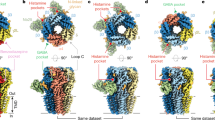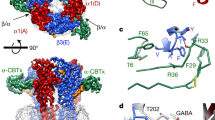Abstract
B-type receptors for the neurotransmitter GABA (γ-aminobutyric acid) inhibit neuronal activity through G-protein-coupled second-messenger systems, which regulate the release of neurotransmitters and the activity of ion channels and adenylyl cyclase1. Physiological and biochemical studies show that there are differences in drug efficiencies at different GABAB receptors, so it is expected that GABAB-receptor (GABABR) subtypes exist2. Two GABAB-receptor splice variants have been cloned3 (GABABR1a and GABABR1b), but native GABAB receptors and recombinant receptors showed unexplained differences in agonist-binding potencies. Moreover, the activation of presumed effector ion channels in heterologous cells expressing the recombinant receptors proved difficult3,4. Here we describe a new GABAB receptor subtype, GABABR2, which does not bind available GABAB antagonists with measurable potency. GABABR1a, GABABR1b and GABABR2 alone do not activate Kir3-type potassium channels efficiently, but co-expression of these receptors yields a robust coupling to activation of Kir3 channels. We provide evidence for the assembly of heteromeric GABAB receptors in vivo and show that GABABR2 and GABABR1a/b proteins immunoprecipitate and localize together at dendritic spines. The heteromeric receptor complexes exhibit a significant increase in agonist- and partial-agonist-binding potencies as compared with individual receptors and probably represent the predominant native GABAB receptor. Heteromeric assembly among G-protein-coupled receptors has not, to our knowledge, been described before.
This is a preview of subscription content, access via your institution
Access options
Subscribe to this journal
Receive 51 print issues and online access
$199.00 per year
only $3.90 per issue
Buy this article
- Purchase on SpringerLink
- Instant access to full article PDF
Prices may be subject to local taxes which are calculated during checkout





Similar content being viewed by others
References
Kerr, D. I. & Ong, J. GABABreceptors. Pharmacol. Ther. 67, 187–246 (1995).
Bettler, B., Kaupmann, K. & Bowery, N. G. GABABreceptors: drugs meet clones. Curr. Opin. Neurobiol. 8, 345–350 (1998).
Kaupmann, K.et al. Expression cloning of GABABreceptors uncovers similarity to metabotropic glutamate receptors. Nature 386, 239–246 (1997).
Kaupmann, K.et al. Human GABABreceptors are differentially expressed and regulate inwardly rectifying K+_ channels. Proc. Natl Acad. Sci. USA(in the press).
Ward, D. T., Brown, E. M. & Harris, H. W. Disulfide bonds in the extracellular calcium-polyvalent cation-sensing receptor correlate with dimer formation and its response to divalent cations in vitro. J. Biol. Chem. 273, 14476–14483 (1998).
Romano, C., Yang, W.- & O'Malley, L. Metabotropic glutamate receptor 5 is a disulfide-linked dimer. J. Biol. Chem. 271, 28612–28616 (1996).
Sodickson, D. L. & Bean, B. P. GABABreceptor-activated inwardly rectifying potassium current in dissociated hippocampal CA3 neurons. J. Neurosci. 16, 6374–6385 (1996).
Lüscher, C., Jan, L. Y., Stoffel, M., Malenka, R. C. & Nicoll, R. A. Gprotein-coupled inwardly rectifying K+ channels (GIRKs) mediate postsynaptic but not presynaptic transmitter actions in hippocampal neurons. Neuron 19, 687–695 (1997).
Slesinger, P. A., Stoffel, M., Jan, Y. N. & Jan, L. Y. Defective γ-amino butyric acid type B receptor-activated inwardly rectifying K+ currents in cerebellar granule cells isolated from weaver and GIRK2 null mutant mice. Proc. Natl Acad Sci. USA 94, 12210–12217 (1997).
Inoue, M., Matsuo, T. & Ogata, N. Characterization of pre- and postsynaptic actions of (−)-baclofen in the guinea-pig hippocampus in vitro. Br. J. Pharmacol. 84, 843–851 (1985).
Uezono, Y.et al. Activation of inwardly rectifying K+ channels by GABABreceptors expressed in Xenopus oocytes. Neuroreport 9, 583–587 (1998).
Couve, A.et al. Intracellular retention of recombinant GABABreceptors. J. Biol. Chem. 273, 26361–26367 (1998).
Hill, D. R., Bowery, N. G. & Hudson, A. L. Inhibition of GABABreceptor binding by guanyl nucleotides. J. Neurochem. 42, 652–657 (1984).
Morris, S. J., Beatty, D. M. & Chronwall, B. M. GABABR1a/R1b-type receptor antisense deoxynucleotide treatment of melanotropes blocks chronic GABABreceptor inhibition of high-voltage-activated Ca+ channels. J. Neurochem. 71, 1329–1332 (1998).
Kenakin, T. Differences between natural and recombinant G-protein coupled receptor systems with varying receptor/G-protein stoichiometry. Trends Pharmacol. Sci. 18, 456–464 (1997).
McLatchie, L. M.et al. RAMPs regulate the transport and ligand specificity of the calcitonin-receptor-like receptor. Nature 393, 333–339 (1998).
Dwyer, N. D., Troemel, E. R., Sengupta, P. & Bargmann, C. I. Odorant receptor localization to olfactory cilia is mediated by ODR-4, a novel membrane-associated protein. Cell 93, 455–466 (1998).
Bischoff, S., Barhanin, J., Bettler, B., Mulle, C. & Heinemann, S. Spatial distribution of kainate receptor subunit mRNA in the mouse basal ganglia and ventral mesencephalon. J. Comp. Neurol. 379, 541–562 (1997).
Malitschek, B.et al. Developmental changes in agonist affinity at GABABR1 receptor variants in rat brain. Mol. Cell. Neurosci. 12, 56–64 (1998).
Olpe, H.-R.et al. CGP 35348: a centrally active blocker of GABABreceptors. Eur. J. Pharmacol. 187, 27–38 (1990).
Shigemoto, R.et al. Target-cell-specific concentration of a metabotropic glutamate receptor in the presynaptic active zone. Nature 381, 523–525 (1996).
Wischmeyer, E.et al. Subunit interactions in the assembly of neuronal Kir3.0 inwardly rectifying K+ channels. Mol. Cell. Neurosci. 9, 194–206 (1997).
Mosbacher, J.et al. P2Y receptor subtypes differentially couple to inwardly rectifying potassium channels. FEBS Lett. 436, 104–110 (1998).
von Heijne, G. Anew method for predicting signal sequence cleavage sites. Nucleic Acids Res. 14, 4683–4690 (1986).
O'Hara, P. J.et al. The ligand-binding domain in metabotropic glutamate receptors is related to bacterial periplasmic binding proteins. Neuron 11, 41–52 (1993).
Acknowledgements
We thank D. Ristig, A. Begrich, I. Meigel and S. Leonhard for technical assistance.
Author information
Authors and Affiliations
Corresponding author
Rights and permissions
About this article
Cite this article
Kaupmann, K., Malitschek, B., Schuler, V. et al. GABAB-receptor subtypes assemble into functional heteromeric complexes. Nature 396, 683–687 (1998). https://doi.org/10.1038/25360
Received:
Accepted:
Issue Date:
DOI: https://doi.org/10.1038/25360



